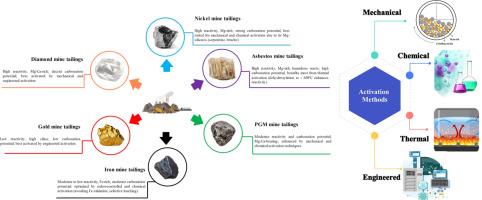Activation methods for enhancing CO2 mineralization via mine tailings—A critical review
引用次数: 0
Abstract
Greenhouse gas emissions from fossil fuel combustion exacerbate global warming, necessitating scalable and cost-effective carbon capture and storage (CCS) strategies. Mineral carbonation has emerged as a promising solution, permanently converting carbon dioxide (CO2) into stable carbonates while simultaneously repurposing mine tailings for sustainable waste management. Ultramafic and mafic mine tailings, which are rich in Mg- and Ca-bearing minerals, provide abundant and reactive feedstocks for CO2 sequestration. This review examines the chemical, mineralogical, and physical characteristics of selected tailings from nickel, asbestos, diamond, gold, iron, and platinum group metal (PGM) mines to assess their carbonation potential, and also introduces a mineral-specific analysis of mechanical activation effects across these materials. However, inherent mineralogical differences necessitate tailored activation strategies to increase CO2 reactivity. To address this, four principal activation methods are evaluated: (1) mechanical activation, which increases the surface area and number of defect sites but has limited dissolution effects; (2) chemical activation, which increases ion availability but raises concerns over reagent costs and waste disposal; (3) thermal activation, which dehydroxylates minerals at ∼650°C to increase reactivity but is energy intensive; and (4) engineered activation, which integrates multiple approaches, such as mechanochemical, thermochemical, and external-field-assisted techniques (e.g., microwaves and ultrasound), to achieve synergistic benefits. However, challenges such as energy optimization, large-scale implementation, and sustainable reagent recovery remain, and these are critically assessed through a cross-method analysis of scalability, cost, and environmental trade-offs. This critical review underscores the transformative potential of mine tailings as valuable resources for commercial-scale CO2 sequestration, bridging climate change mitigation with circular economy principles and advancing sustainable industrial practices.

利用尾矿促进CO2矿化的活化方法综述
化石燃料燃烧产生的温室气体排放加剧了全球变暖,需要可扩展且具有成本效益的碳捕集与封存(CCS)策略。矿物碳酸化已经成为一种很有前途的解决方案,它将二氧化碳永久地转化为稳定的碳酸盐,同时重新利用矿山尾矿进行可持续的废物管理。超镁铁质和镁铁质尾矿富含含镁、含钙矿物,为固碳提供了丰富的活性原料。本文研究了镍、石棉、钻石、金、铁和铂族金属(PGM)矿山中选定的尾矿的化学、矿物学和物理特性,以评估其碳化潜力,并介绍了对这些材料的机械活化效应的矿物特异性分析。然而,固有的矿物学差异需要定制活化策略来提高CO2反应性。为了解决这个问题,评估了四种主要的活化方法:(1)机械活化,它增加了缺陷位点的表面积和数量,但溶解效果有限;(2)化学活化,这增加了离子的可用性,但引起了对试剂成本和废物处理的担忧;(3)热活化,在~ 650°C下使矿物脱氢以提高反应性,但这是一种能量密集型的反应;(4)工程激活,它集成了多种方法,如机械化学、热化学和外场辅助技术(如微波和超声波),以实现协同效益。然而,诸如能源优化、大规模实施和可持续试剂回收等挑战仍然存在,这些挑战通过对可扩展性、成本和环境权衡的跨方法分析进行了严格评估。这一重要审查强调了尾矿作为商业规模二氧化碳封存的宝贵资源的变革潜力,将减缓气候变化与循环经济原则联系起来,并推进可持续的工业实践。
本文章由计算机程序翻译,如有差异,请以英文原文为准。
求助全文
约1分钟内获得全文
求助全文

 求助内容:
求助内容: 应助结果提醒方式:
应助结果提醒方式:


